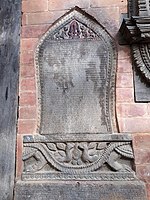Vishva Lakshmi
Appearance
| Vishva Lakshmi Devi | |
|---|---|
| Queen of Bhaktapur | |
 Gilt copper statuette from the 17th century | |
| Queen Consort of Bhaktapur | |
| Tenure | 21 September 1696 – 19 May 1722 |
| Predecessor | Lālamati |
| Successor | Briddhi Lakshmi |
| Born | Unknown |
| Died | Unknown date Bhaktapur, Nepal |
| Spouse | Bhupatindra Malla |
| Issue | Ranajit Malla |
| Dynasty | Malla Dynasty (by marriage) |
Vishva Lakshmi (Nepal Bhasa: 𑐧𑐶𑐱𑑂𑐰𑐮𑐎𑑂𑐲𑑂𑐩𑐷) was the queen consort of Bhaktapur and the spouse of Bhupatindra Malla, who ruled from 1696 to 1722.[1][2] She was also the mother of Ranajit Malla, the last king of Bhaktapur.[3] She was married to Bhupatindra Malla on 4 November 1687.[4]
Vishva Lakshmi commissioned the temple of Brahmayani in Panauti and donated lands for funding the regular worship of the goddess.[5][6] There is also a statuette of her at the temple of Brahmani in Panauti.[6] Her last reference comes from a copper plate inscription dated to April 1723 which mentions her donation of some land for funding a ritual worship of Taleju, the tutelary goddess of the Mallas.[7]
Gallery
-
Mural from 1708 at the royal palace of Bhaktapur depicting Vishva Lakshmi and her husband as a divine couple.[8] Vishva Lakshmi also had a small mole on her chin, as can be seen in this mural.[8]
-
Gilt copper statuette at the Art Gallery of New South Wales.[9] Based on her jewellery, this statuette seems to have been made for her wedding.
-
The temple of Brahmayani in Panauti, completed in 1715 was commissioned by Vishva Lakshmi.
-
Highly damaged miniature of Vishva Lakshmi (far left) from a Paubha from the 18th century.
See also
References
- ^ Shrestha, Sahina. "An illustrated history of the Chitrakars | Nepali Times Buzz | Nepali Times". archive.nepalitimes.com. Retrieved 2022-02-10.
- ^ Regmi 1966, p. 237.
- ^ Upadhaya 2009, p. 202.
- ^ Bajracharya, Chunda (January 1996). "मल्लकालको एतिहासिक सामग्री– धर पौः" (PDF). Contribution to Nepalese Studies. 23.
- ^ Regmi 1966, p. 243.
- ^ a b Municipal Profile of Panauti (PDF) (in Nepali). Panauti Municipality. 2018. p. 16. Archived from the original (PDF) on 29 July 2022.
- ^ Vaidya, Tulasī Rāma (2002). Bhaktapur Rajdarbar. Centre for Nepal and Asian Studies, Tribhuvan University. p. 79. ISBN 978-99933-52-17-4.
- ^ a b Shrestha, Purushottam Lochan (22 November 2014). "Pachpanna jhyālē darbārkō vishvarupa". Lalitkala Magazine (in Nepali).
- ^ "Portrait of the Malla King Bhupatindra and Malla Queen". Global Nepali Museum. Archived from the original on 2020-09-28. Retrieved 2021-12-16.
Bibliography
- Upadhaya, Shreeram Prasasd (2009). Nepal ko Prachin tatha Madhyakalin Itihas (in Nepali). Ratna Pustak Bhandar. pp. 194–202. ISBN 978-9993304555.
- Raj, Yogesh (2018). Ranahar (in Nepali). Nepa~laya Publications. ISBN 9789937921244.
- Regmi, D. R. (1966). Medieval Nepal: A history of the three kingdoms, 1520 A.D. to 1768 A.D. Firma K. L. Mukhopadhyay.

![Mural from 1708 at the royal palace of Bhaktapur depicting Vishva Lakshmi and her husband as a divine couple.[8] Vishva Lakshmi also had a small mole on her chin, as can be seen in this mural.[8]](/media/wikipedia/commons/thumb/2/27/Bhaktapur_37172727277272.png/250px-Bhaktapur_37172727277272.png)
![Gilt copper statuette at the Art Gallery of New South Wales.[9] Based on her jewellery, this statuette seems to have been made for her wedding.](/media/wikipedia/commons/thumb/1/1e/Malla_Queen_of_Bhaktapur.jpg/191px-Malla_Queen_of_Bhaktapur.jpg)


